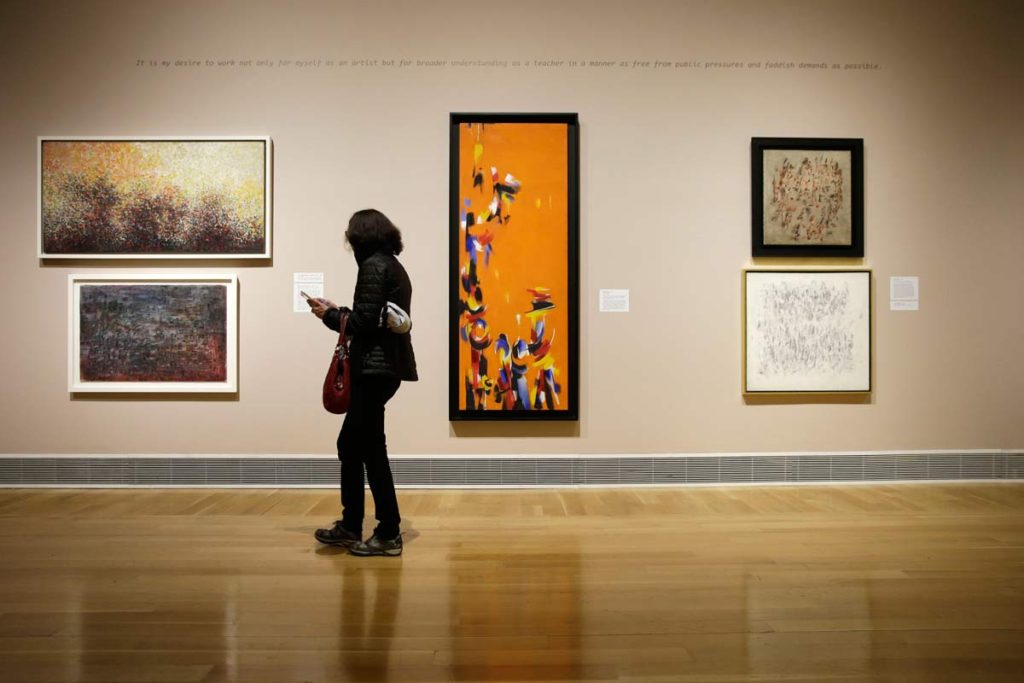Originally published in Art in America’s July 2016 issue. â—Šâ—Š
Norman Lewis (1909–1979) was an energetic participant in the Harlem Renaissance and one of the only African-American painters who associated himself with the Abstract Expressionists. While he founded the Spiral Group (active from 1963 to 1965) with Romare Bearden, Charles Alston, and Hale Woodruff to explore the place of black artists in the Civil Rights Movement, he stated on many occasions that his aesthetic goals were separate from his activism.
The traveling survey “Procession: The Art of Norman Lewis,†which premiered at the Pennsylvania Academy of the Fine Arts (PAFA) and opens at the Amon Carter Museum of American Art in Fort Worth, Texas, on June 4, is a momentous revisionist effort, encompassing nearly one hundred works and spanning fifty years. It opens Lewis’s work to broader interpretation, revealing a more complex relationship between his art and politics than his own declarations indicate. Joining a short but potent list of Lewis surveys—including a 1976 show at the City University of New York (the only retrospective heldduring his lifetime) and the 1998 exhibition “Norman Lewis: Black Paintings 1946–1977†at the Studio Museum in Harlem—“Procession†offers a range of paintings, as well as rarely seen examples from Lewis’s forays into crafts, highlighting his handmade dolls that employ clay, weaving, and beadwork, among other techniques. Archival material from his trove of sketches, photographs, ephemera, and journal articles (written on subjects ranging from art history to anthropology and psychology) provides insight into his artistic milieu and interests and points to his acute awareness of the country’s racial injustices.
The PAFA presentation unfolded through a series of irregularly shaped enclosures delineated by freestanding walls. Organized according to themes including the work’s relation to music, to natural forms, and to the Civil Rights Movement, the loosely chronological installation allowed viewers to make connections among paintings caught in their peripheral vision, which was an illuminating way to view an artistic corpus often described as heterogeneous.
Early figurative pieces, which were in keeping with the Social Realism common among his peers, offer signs of Lewis’s abstract leanings. In Title unknown (Potato Eaters), 1945, the heads and torsos of five schematic figures cluster over a smattering of potatoes. A black line describing the edge of a table in the lower left sheds its illusionistic role as it rises into the border of a framelike device that encloses all but the head of the tallest figure. Participating in the figure group and the background, the black line functions on three levels: psychically, descriptively, and abstractly. Multifaceted connections among human forms and abstract lines deepen the experience of works like Congregation (1950), a small painting in which a spiral, articulated with lines and spots of pigment, emerges from a washy black ground. The linear tracery in the spiral suggests a succession of bending limbs and feet.
The works in the “Civil Rights†section, especially, read against Lewis’s insistence that his art was entirely abstract. Seen together, paintings like Alabama (1960), Redneck Birth (1961), and Journey to an End (1964) reveal Lewis’s dexterity, as the formal dynamics of flat abstract color constitute the emotional motor of the compositions. In Journey to an End, made the same year as the Civil Rights Act was instituted, a starburst of white calligraphic brushwork and exposed canvas slices open a solid black field. It becomes difficult not to see referential cues in this painting. The stark clash of black and white maps onto national reports of racial tensions, and the starburst form can be seen as a person racing forward with pinwheeling limbs. In the abstractions from the ’70s, like Confrontation (1971) and Triumphal (1972), the aggregations of calligraphic, somewhat figural marks are as much about gathering and collective movement as they are about color and form.
By the end of “Procession,†the viewer has the sense that the observational, the figural, the abstract, the formal, the psychic, and the spiritual accumulated as strata in Lewis’s body of work. The richness of these layers rewards the viewer’s repeated return.
